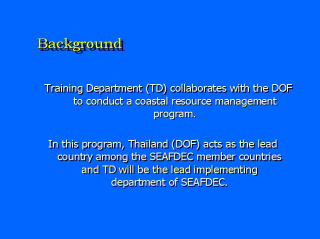
Under Fisheries Consulting Group (FCG) scheme, Thailand acts as the lead
country among the SEAFDEC member countries and TD will be the lead implementing department of SEAFDEC.Since August last year, staff of the socio-economic section, TD, had made great effort to prepare a five year plan in collaboration with the DOF’s officials. Finally, on October 5, we agreed to finalize the proposal and proposed it to the DOF. And on November 9, we got the official approval from the DOF and TD to start this project. We named this project, “Locally
Based Coastal Resource Management in Pathew District, Chumporn”.(LBCRM-PD). This is a very new project.
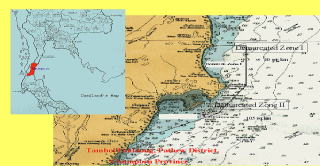
Before SEAFDEC joined, the DOF had started at implementing a coastal resource management project, as a Royal Project on behalf of His Majesty the King. It had drawn up roughly a five-year plan. The project
site was already selected in Tambol Pakklong, Pathew District, Chumporn
Province. The DOF placed a great emphasis on promoting the sustainable use of coastal resources at the project site. Through achieving a consensus among local fishers, the DOF decided to proclaim the demarcation of coastal fishing zones preserved for small-scale fisheries. Zone I was drawn in August 2000. And the people
and the DOF agreed to set up Zone II in May 2001. The two zones cover 145
sq. km, being surrounded by 3 km lines with distance from the beach. The project intends to manage the demarcated zones where particular types of fishing operations such as trawl, push nets, cockle cast net, and anchovy purse seine & falling net during night time are prohibited.
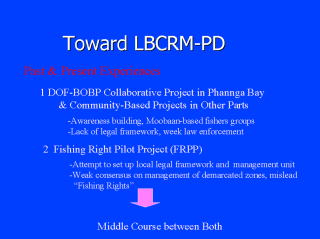
LBCRM-PD stands on the middle course between community-based projects that have been implemented so far and Fishing Right Pilot Project in Prachuab Khiri Khan Province. The conventional community-based approaches have succeeded in enhancing awareness building, establishing fishers groups. But due to lack of legal framework and week law enforcement, they do not always make progress. Fishing Right Project is under way. Attempt to set up local legal framework and management units is very challenging. But the concept of “Fishing Rights” misled fishers and stakeholders. Legal support to the
management of demarcated zones is still week. LBCRM-PD picks up successful lessons from two kinds of pilot projects.
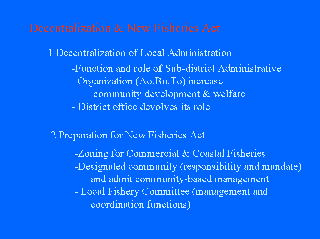
Thai government goes on the process of decentralization. Sub-district Administrative Organization (Ao.Bo.To) increases its function and role for community development and people’s welfare. It may take over some functions of fisheries management from a District office of Fisheries. It becomes an autonomous organization with taxation and budget allocation.
The government is preparing for the amendment of the Fisheries Act B.E.2490 in all aspects to fit in with the reality of present fisheries development. Zoning will be set up for coastal fisheries and commercial fisheries. A
"designated community” becomes a management body. The community will
be delegated rights and responsibilities regarding the management and implementation of appropriate measures for sustainable use of coastal resources. Local Fishery Committee functions management and coordination within certain defined areas. It has the authority to issue local fishing permits for particular areas, and to issue written permission. The decentralization of local administration and the proclamation of new fisheries act are uncertain. However, we should take these two future factors into account of the project plan.
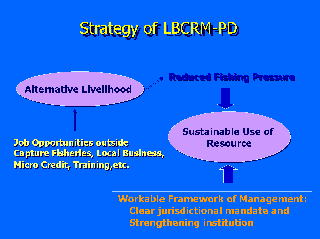
Over-fishing is a problem of poor law enforcement, also the problem, related to open-access
fishing regimes, stagnant, declining or booming economies, lack of alternative
income sources, and poverty. A more integrated approach should be planed for coastal fisheries management, considering the site’s social, economic, cultural and other environmental backgrounds. We need clear jurisdictional mandate and well-mechanized institution. Fishers and stakeholders participation in fisheries management is a decisive factor to build such a framework. The creation of alternative job opportunities helps to reduce fishing efforts. Fishers and family members have to increase alternative income sources inside and outside fishing communities. They
organize local business for various economic activities. So that covers the background of the collaborative project.
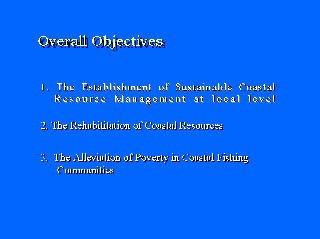
This project has three overall objectives.
1) 1) The establishment of sustainable fisheries management with a participatory
approach.
2) The Rehabilitation of Coastal Resources.
2) The Rehabilitation of Coastal Resources.
Over-fishing and overcapitalization have led to the depletion of coastal resources. Fishers, local communities and
government agencies should adopt any appropriate measure to rehabilitate coastal marine resources.
government agencies should adopt any appropriate measure to rehabilitate coastal marine resources.
3) Alleviation of Poverty in Coastal Fishing Community.
Alleviation of poverty is the most basic strategy toward establishing the
sustainable use of coastal resources. Successful pilot projects of Community-based Fisheries Management (CBCM) in the Southeast
Asian region indicate that much effort to reduce poverty in local community
devoted for poor small-scale fishers to survive without using destructive
fishing apparatus.
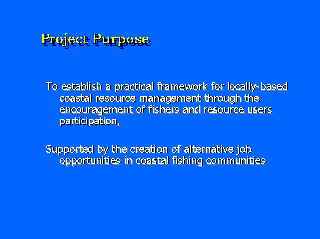
The project direct purpose is:
to establish a practical framework of locally-based coastal resource management through encouraging fishers’ participation, supported by the creation of alternative job opportunities in coastal fishing communities.
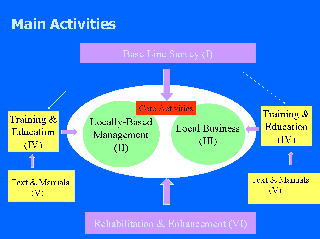
The project has six main activities.
1) Base Line Survey
2) Encourage and Extend Locally-Based Coastal Resource Management
3) Encourage Local Business
3) Encourage Local Business
4) Enhance Human Resource Capability and Participation
5) Develop Extension Methodologies and Strengthening the Extension System
6)
6)Rehabilitate and Enhance Coastal Resources
Core activities are 2) Encourage and Extend Locally-Based Coastal Resource Management and 3) Encourage Local Business.
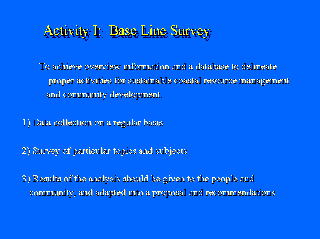
Activity I is the base line survey, to get the necessary information and data both for the establishment of sustainable coastal resource management and for community development, with the participation of resource users and stakeholders. The local demand-led project needs a feasibility study in depth.Survey fields are mainly oceanography, environmental aspects, fishing techniques,
and socio-economic aspects. The survey includes some particular topics like obtaining people’s ideas on management aspects and their demand for the project activities, and identifying a beneficiaries group of supporters or those negatively affected. Through experiments at the project site, the base line team will develop and provides a package of baseline information relevant to the planning and management of coastal fisheries and resources. The results of any analysis will be given to the people and communities, and adopted into a proposal and recommendation for a LBCRM framework.
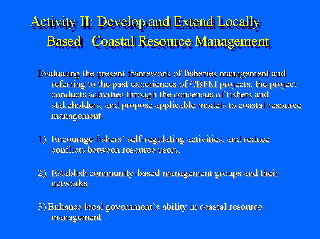
Activity II is at the center of the project activities. The project will promote the establishment of workable framework for coastal
resource management and encourage resource users and stakeholders to participate
in the management of demarcated coastal areas. Evaluating the present framework of fisheries management and referring
to the past experiences of CBFM projects in Thailand and other member countries, the project will conduct activities through achieving a consensus of users and stakeholders
for a LBCRM. 1)The project encourages fishers’ responsible fishing and aquaculture operations and their participation in the management of the demarcated coastal zones.It strengthens the institutional framework of coastal resource management, establishing community-based management groups and their network, and enhance the managerial ability of sub-district administrative organization,
particularly Ao. Bo.To., in coastal resource. People, their group, Ao.Bo.To and the project staff are discussing what LBCRM system and management should be required.
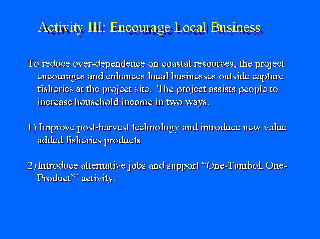
The Activity III concerns the increase and creation of alternative job
opportunities, which also stands as a core activity. To reduce over-dependence on coastal resources, the project assists the people to increase income in two ways by encouraging local business. The first way to increase income is not by expanding the amount of catch
effort investment, but by improving technologies of handling, marketing
and processing of fisheries products, especially squid and anchovy. The
second is to create alternative job opportunities outside capture fisheries.
Promotion of fish and shell culture will be included into this activity.
Women have a vital role in job creation with the promotion of small-scale
local business. Marine eco-tourism is a targeted activity, too. Thai government
has provided a number of programs for alternative jobs and livelihoods
in rural community. In collaboration with other local agencies and NGOs,
the project support “One-Tambol (Village), One-Product” scheme. We have
scceeded in the encouraging of fish processing to women’s groups.
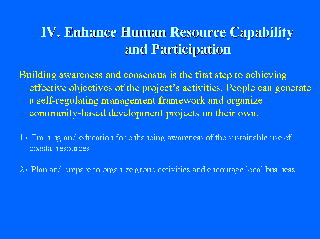
Activity IV concerns the matters of training and education.At the first year, most of the project activities are related to education and training matters. They are the most basic activity leading to full success of this
project. Participatory training courses have been planned and implemented.
Topics of training courses are mainly related to the Activity II and the Activity III. Preparation of a series of training courses on Activity II should be considered
on the purpose of resource management in the demarcated zones, responsible
fishing and aquaculture operations. For the Activity III, the project staff arrange practical training courses for fish processing and aquaculture technology, which are given the first priority. Marine tourism and micro credit activities
are the next targets. Fishermen, their wives and fish traders need to obtain
anchovy- and squid-based products technology, and cage culture for grouper
and sea bass.
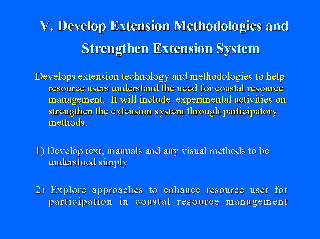
Activity V is related to develop extension methodologies. For enhancing awareness building for coastal resource management, extension services are required to develop their technologies and methodologies. Text, manuals and any visual methods through experiments on extension and training activities should be prepared and developed by the project. The project explores new approaches to enhance people’s self-regulation on fishing activities and participation in community development.
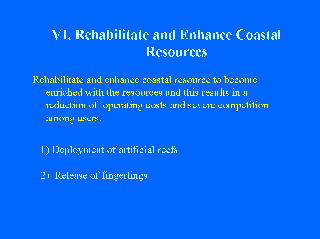
Activity VI is the rehabilitation and enhancement of coastal resources. The DOF prepares for two kinds of activities.
1) The deployment of artificial reefs around the demarcated fishing zone
Not only to enhance coastal resources but also to protect illegal commercial-scale fishing boats, artificial reefs will be deployed around the demarcated coastal areas.
2) Releasing of fingering
To increase particular target species, the DOF prepares for fingering production and arrange releasing. This activity will be carried out with advertising campaign for environmental issues in the project areas.
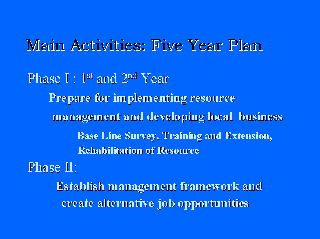
The duration of this project is five years, which is divided into two phase.
The first phase focuses mainly on the activities of a base line survey and training matters with a campaign for enhancing awareness building. Rehabilitation activities will be started in the first phase. During the second phase, the project concentrates on the establishing and functioning of a management framework and the promotion of alternative job opportunities.
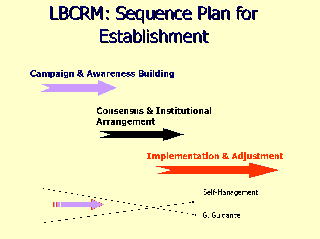
The project has a sequence plan for extending a LBCRM framework. Three development stages are prepared. In the first stage, the main activities are the expansion of the comprehensive coastal management campaign using posters and pamphlets, and providing programs of education
and training. In the second stage, we encourage resource users and stakeholders to develop
their own regulating activities. Ao.Bo.To, community-based management groups and its networks should achieve a consensus on self-regulatory resource utilization and make agreement. Institutional arrangement should be strengthened at this stage. A further development of self-regulatory activities with a monitoring function will be in the third stage. By the end of the project, a LBCRM schedules to work well. The project staff phase out their involvement in the project activities
and encourage the people’s increasing contribution.
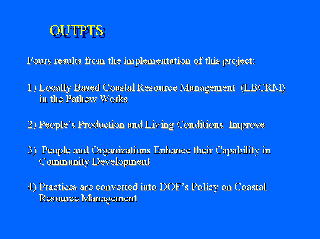
We expect at least four results from the implementation of this project.
1) Locally-based Coastal Resource Management (LBCRM) in the Pathew works
2) People’s Production and Living Conditions Improve
3) People and Organizations Enhance their Capability in Community Development
4) Practices at the project site are converted into DOF’s Policy on Coastal
Resource Management.
This project will be the first pilot project for the decentralization of fisheries management. The project staff and Ao.Bo.To are expected to explore the forms and procedures of gear and fishers registrations, and
prepare for practical manuals.
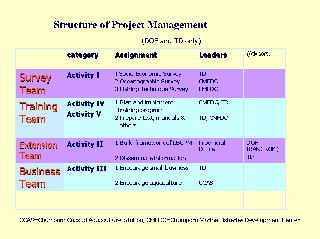
The project implementing agencies are the DOF, TD/SEAFDEC, Provincial and District Office of the DOF, Chumporn Marine Fisheries Development Center, Coastal Aquaculture Center in Chumporn and Prachuab
Khiri Khan Province. These agencies share responsibilities and tasks. The Chumporn Marine Fisheries Development Center and Provincial Office of the DOF are core agencies on the government side, and Ao.Bo.To and fishers groups at the project site. The project has a team-based structure to effectively operate activities. . At the project site, these teams and the people’s groups cooperate together. Organization of each group is flexible and staff members of TD and DOF
change their responsibility and tasks if necessary. TD supports the DOF, Ao.Bo.To and the people’s groups to involve the core activities of the project, doing research and having a training functions in collaboration with Chumporn Marine Fisheries Development Center. TD also gives advice on self-regulating activities, registration, licensing,
training, research and any project related activities. Successful experiences and lessons of CBFM and any coastal resource management programs in the Southeast Asian region can be introduced to this project through the SEAFDEC information mechanism.
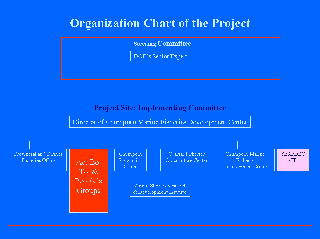
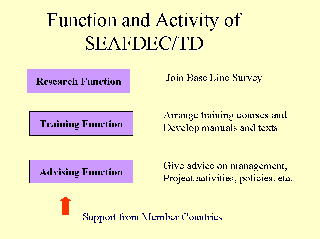
TD supports the DOF, Ao.Bo.To and the people’s groups to involve the core activities of the project, doing research
and having a training functions in collaboration with Chumporn Marine Fisheries
Development Center. TD also gives advice on self-regulating activities, registration, licensing,
training, research and any project related activities. Successful experiences and lessons of CBFM and any coastal resource management programs in the Southeast Asian region can be introduced to this project through the SEAFDEC information mechanism.
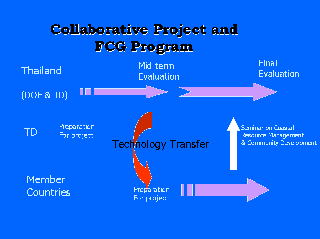
Establishing sustainable coastal resource management is an urgent need in the ASEAN region. Technologies, knowledge and lessons learned through the implementation of this project will be transferred to other SEAFEC member countries through its information mechanism. This may be useful for the member countries to review their own policies and steer a new direction of coastal resource management projects. We also expect that those member countries that have experience in the field of coastal resource management projects will give practical and appropriate advice to our project.
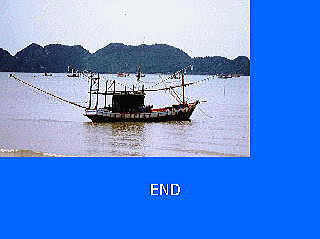
Our project has just started, and not many activities have been done yet. However, we’ve made a progress of building basic structure for LBCRM. The next step will move to experiments on the establishment of a voluntary registration system.